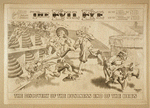In this provocative article, Teresa Barnett defines a type of relic collecting that cannot be captured solely by the Victorian sense of material memory. She uses as her example the schoolteacher and collector Christian Sanderson whose home is now a museum in Chadds Ford, Pennsylvania:
[Christian] Sanderson's commemorations were more interesting when they dealt with time itself, when they found a formal structure, that is, which somehow encoded a piece of the lost time they were attempting to preserve. Looked at in this way, his relics, solid objects though they are, can be seen as bits of congealed time. And they are at their most poignant--and intriguing--when, in their reified form, they manage to reenact the vanished time of their making.
To commemorate Woodrow Wilson's death, for instance, Sanderson saved the pages of a counting exercise his schoolchildren were working on as the school bell tolled for the funeral. That exercise may summon memory simply because it was literally "on the spot" at the significant moment, but in a twist that can be seen as a form of wit, it also summons memory through its simple mimetic form: "one, two, three, four, five," like the tolling of the bell itself, as if the children transcribed the knell of mourning onto the coarse paper of their exercise books. Looking at the counting exercise some seventy years later, then, is like summoning up a fragment of 1920s time.
--Teresa Barnett, "Tradition and the Individual Memory: The Case of Christian C. Sanderson" in Acts of Possession: Collecting in America, Edited by Leah Dilworth (2003)
Monday, September 21, 2009
Subscribe to:
Post Comments (Atom)






No comments:
Post a Comment